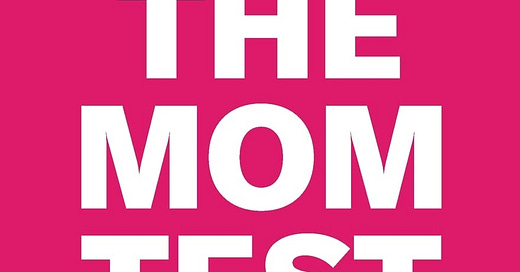The Mom Test: Let's Break It Down
This Friday ->The Mom Test: How to talk to customers & learn if your business is a good idea when everyone is lying to you by Rob Fitzpatrick [3 min reading]
On Startup Salad I break down a business book’s key takeaways in a simple, digestible format, just like a good salad!
Hey, it’s Fede!
If you’ve talked about your startup with even just 5 people in the ecosystem, there’s a 99.99999% chance at least one of them has mentioned that book.
Yes, that one.
THE MOM TEST.
Everyone’s heard of it.
But how many have actually read it carefully?
And more importantly:
Is it useful for startup founders?
Today's book: The Mom Test: How to talk to customers & learn if your business is a good idea when everyone is lying to you by Rob Fitzpatrick
This book shows you how to talk about your startup to your potential clients or investors and get real, useful feedback not just polite lies.
In this edition of Startup Salad, let’s see if it’s worth your time.
Let’s start!
Pssst: Every time you see a🥗 it means the takeaway is very hot!
What is the mom test?
The idea behind The Mom Test is super simple:
Don’t ask your mom for feedback on your startup idea,
she’ll lie to you.
(Not out of malice, of course. She just doesn’t want to hurt your feelings.)
But here’s the catch:
It’s not just your mom.
Almost everyone will give you positively biased feedback, unless they hate you (and even then, it’s not exactly helpful).
Why?
Because people want to be nice.
They’ll cheer you on, say “wow, great idea!” and leave you feeling pumped.
But what you actually need is not encouragement.
You need to build the right product with the right offer, for the right market. 🥗
So how do you get real insights?
That’s what the book is all about:🥗
A set of smart, practical tips on how to ask the right questions, avoid traps, and get honest, useful feedback from potential customers.
No sugarcoating. Just clarity.
Key Takeaways for Getting Real, High-Quality Feedback
Here are the core rules of The Mom Test:
Stop pitching. Seriously. 🥗
If you catch yourself rambling, stop.
Turn it back into a normal conversation.
No one wants a 5-minute monologue.Ask about the past, not the future. 🥗
“Would you use this?” is useless.
Ask: “How did you solve this problem last time?”Ignore compliments. Look for commitment.
Praise is free.
Time, money, or concrete actions? That’s what matters, try to go there.Validate the problem, not your idea. 🥗
Have they actually faced this problem?
Have they tried solving it?
If not, they’re unlikely to pay for your product.Customers don’t know what they want.
Dig deeper. Don’t build what they ask for; ask questions to understand the real problem behind it.Listen more than you talk.
Even if their feedback sounds wrong, follow their reasoning, it might unlock new insights.Most people aren’t your customers.
Accept it, thank them, and move on.
Don’t waste time convincing the wrong crowd.
The Only Output That Matters from The Mom Test
When talking to potential customers, your goal is to get one of three valuable outcomes:
Facts
Learn about their real problems, the segment you should focus on, and the features they actually need. This is your validation goldmine.Commitment 🥗
If the conversation goes well, try to secure a Letter of Intent (LOI). It’s a great follow-up tool and a strong signal for future investors.Advancement
In the best-case scenario, where you already have something to show, push for a pre-order or schedule a sales meeting.
This is what I found most interesting in the book.
Some tips about which biases to avoid were really helpful for me.
Let me know what you think!
The guidelines you need to build your startup:
See you next Friday,
Federico Lorenzon








